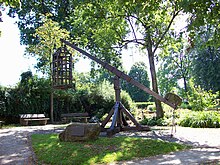Shame basket

The disgraceful basket or cage (also known as a push chair) was a means by which an honor penalty was carried out in the late Middle Ages and in the early modern period .
Evidence for its application
Right on the border between Wernigerode and Hasserode was the Kesselmühlenteich until 1907/1908, in the immediate vicinity of which two busy streets crossed. There was a disgraceful basket hanging from a large pole above the water. In it were thieving women and children imprisoned and submerged in the presence of a large crowd in the boiler mill pond. Catharina Bethmann from Darlingerode is one of those women who had to endure this fate. During the harvest season in 1595 she had stolen six sheaves of grain from the field and was put in the basket of shame and dipped into the water as a punishment. As a public deterrent, the basket, which was renewed several times, remained hanging on the Kesselmühlenteich for many decades. It was not until a strong spring storm in 1731 tore it off the rack. Since this type of public punishment was already obsolete by the time of the pietism that began in Wernigerode , Count Christian Ernst zu Stolberg-Wernigerode decided not to replace the basket and had it disposed of for the sum of eight groschen.
Copies still in existence today

- In the Medieval Crime Museum in Rothenburg ob der Tauber you can still see such an iron baskets or cages. The basket of shame in Wernigerode, however, was not made of iron, but of oak, as is evident from an invoice from 1613/14.
- " Bäckerschupfen " in the Gifhorn Mill Museum
- Push chair in Rüthen
- Schandkorb in Leutschau (Levoča) in Slovakia - Photo
Web links
literature
- W. Andrew: Old Time Punishments (Hull, 1890)
- AM Earle: Curious Punishments of Bygone Days (Chicago, 1896)